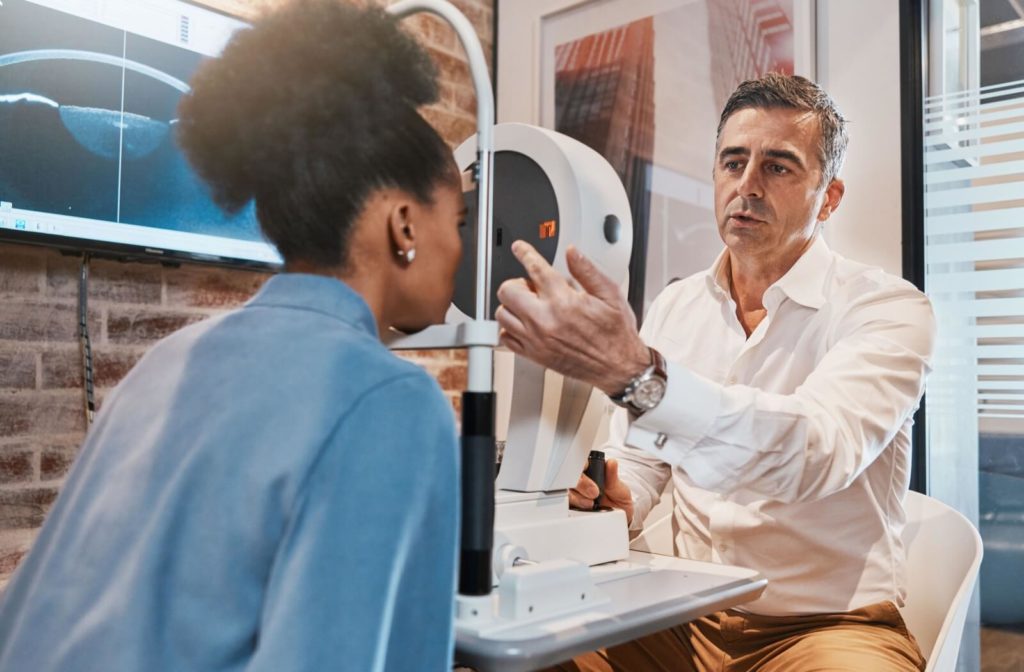Pink eye is more common than most people think. It’s a highly contagious eye condition that can easily spread to others nearby if you aren’t careful. Often recognizable by redness, watery eyes, and itching sensations, pink eye can be an extremely frustrating experience. However, it’s important to note that this isn’t the only cause of redness around the eyes; plenty of different eye conditions can be mistaken for pink eye.
Some common conditions often misdiagnosed as pink eye include dry eye, uveitis, and blepharitis. The visible redness can also develop due to environmental factors like exposure to smoke, dust, or pollen and even a lack of sleep. If you ever notice redness in your eyes, visit your optometrist; don’t try to self-diagnose an infection.
What is Pink Eye?
Your eyes and eyelids are lined with an extremely thin membrane called the conjunctiva. It’s a clear tissue that covers the white part of your eye, helping to keep your eyes moist and protect them from irritants like dust, dirt, and other foreign particles.
Sometimes, this conjunctiva can become inflamed or infected. The tiny blood vessels inside start to swell, leading to a pink or red appearance. This can occur in one or both eyes. When this occurs, it’s called “conjunctivitis” or “pink eye.”
Types of Pink Eye
There are 3 types of pink eye:
- Allergic
- Bacterial
- Viral
Each type has its own cause, symptoms, and treatment. It’s essential to learn how to recognize the difference between the 3 types since treatment isn’t universal, and it can be easy to mistake pink eye for something else. By learning about the different forms of the condition, you can take proactive measures to prevent it from spreading.
Allergic Pink Eye
Allergic pink eye develops when the immune system goes into overdrive to fight against an allergen. The blood vessels flare up, and your eye tries to expel the irritant. Allergic pink eye often appears alongside other allergy symptoms, like a runny nose, coughing, and sneezing.
This can eventually lead to:
- Increased tear production
- Itchiness in the eyes
- Swollen eyelids
- Sensitivity to light
There is good news here; allergic pink eye isn’t contagious. This can often be treated with antihistamines and over-the-counter allergy medication.
Bacterial Pink Eye
Sometimes, a bacterial infection causes pink eye to develop. The bacteria inflame the conjunctiva, leading to the tell-tale visible pinkness associated with the condition.
Bacterial pink eye can cause:
- Yellow or greenish discharge from the eye
- Crusting around the eyelids, especially after sleep
- Redness and swelling
- Possible ear or respiratory infections accompanying the eye symptoms
Unlike allergic pink eye, bacterial pink eye can be highly contagious. It often spreads through direct contact with an infected person or through contaminated surfaces.
It’s essential to seek prompt treatment if you think you have bacterial pink eye—it can swiftly spread to other people nearby. Allergic pink eye can be treated through antibiotics and will usually clear up within a week with proper treatment.
Viral Pink Eye
Viral pink eye occurs when a viral infection causes your symptoms to develop. This often appears darker than the other types of pink eye.
Viral pink eye can cause:
- Watery discharge from the eye
- Itchy or irritated eyes
- Redness of the eye
- Sensitivity to light
Viral pink eye is also highly contagious and can easily spread to others through coughing, sneezing, or any infected or contaminated surfaces.
It’s important to note that antibiotics can’t help with viral pink eye, as it’s not caused by a bacterial infection. Instead, treatment for viral pink eye usually focuses on relieving symptoms; the condition usually resolves itself within a week or two.
What Can Make Your Eyes Go Red?
Pink eye isn’t the only condition that causes red eyes. The human eye is a remarkably sensitive organ; the redness can be due to all kinds of common eye conditions.

Other common causes of visible redness in the eyes include:
- Dry eye, a condition that develops due to an imbalance in the tear film
- Blepharitis, the inflammation in the eyelids due to bacterial spread
- Broken blood vessels, often due to trauma
- Uveitis, the inflammation of the middle layer of the eye
- Overuse of contact lenses
- Environmental factors, like exposure to dust, pollen, or smoke
- A lack of sleep
Because this condition can be caused by so many potential factors, it’s crucial to visit an eye care professional if you notice redness or any other symptoms. They’ll be able to assess your eyes to determine what’s causing your symptoms.
When to See an Optometrist
If you’re dealing with anything unusual regarding your eyes or vision, talk to our team at Downtown Eye Care & The Contact Lens Department. We can diagnose your condition and help design a treatment plan so you can find relief. Don’t let conditions like pink eye disrupt your day; book an appointment with our team!















